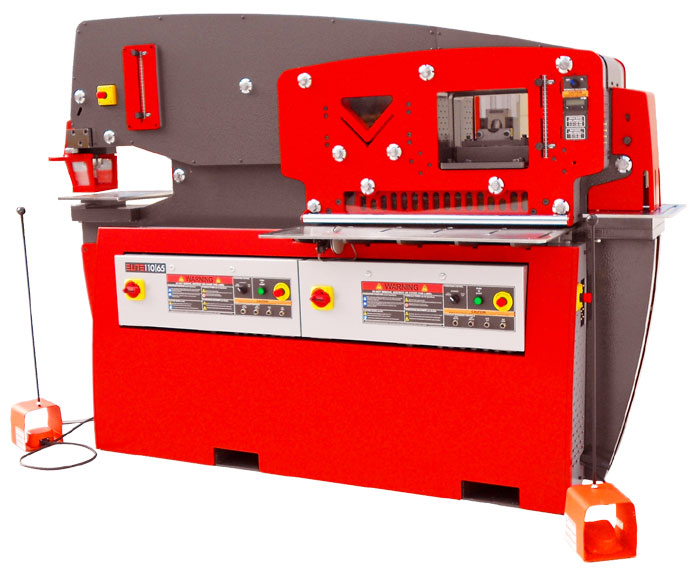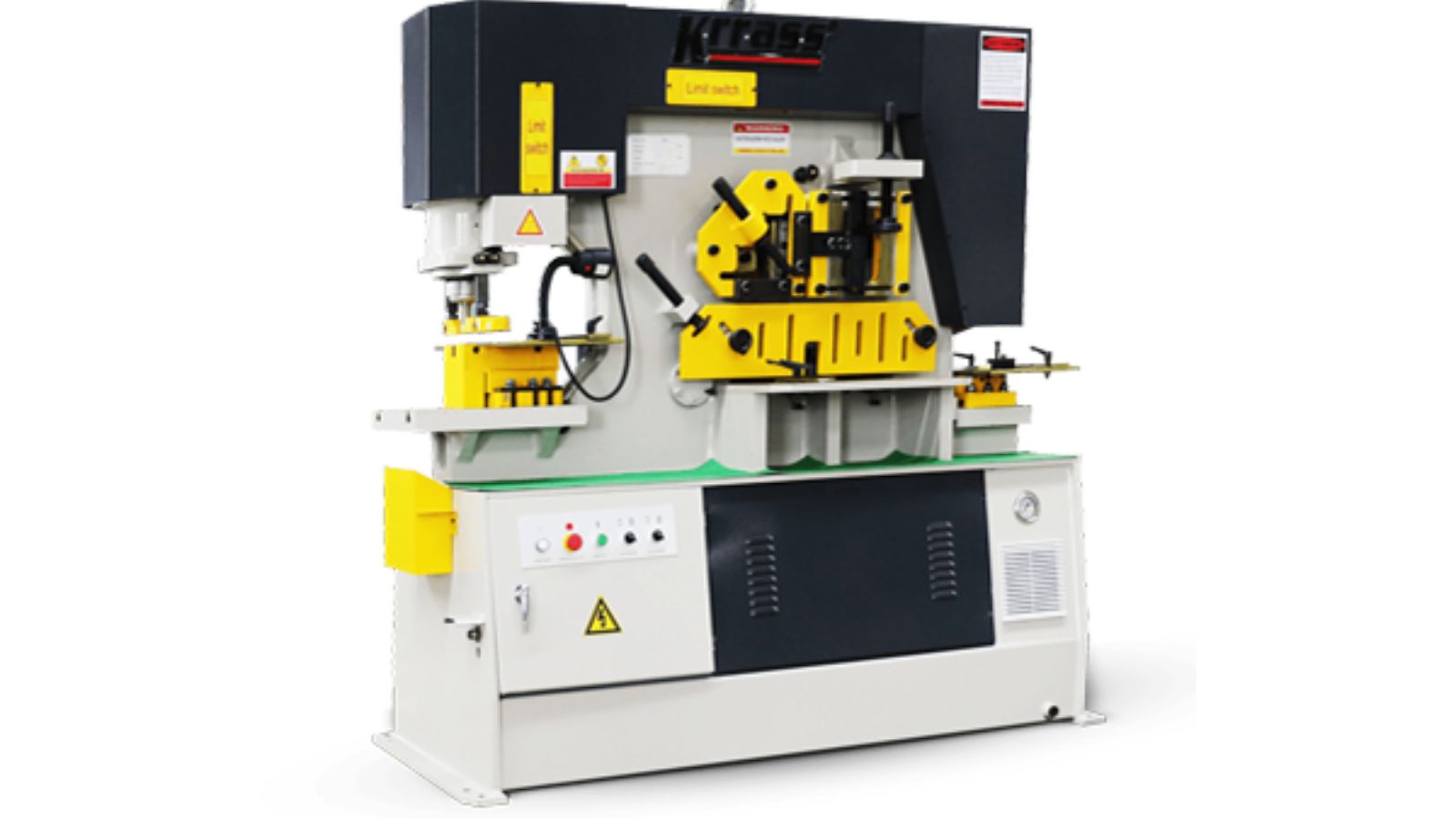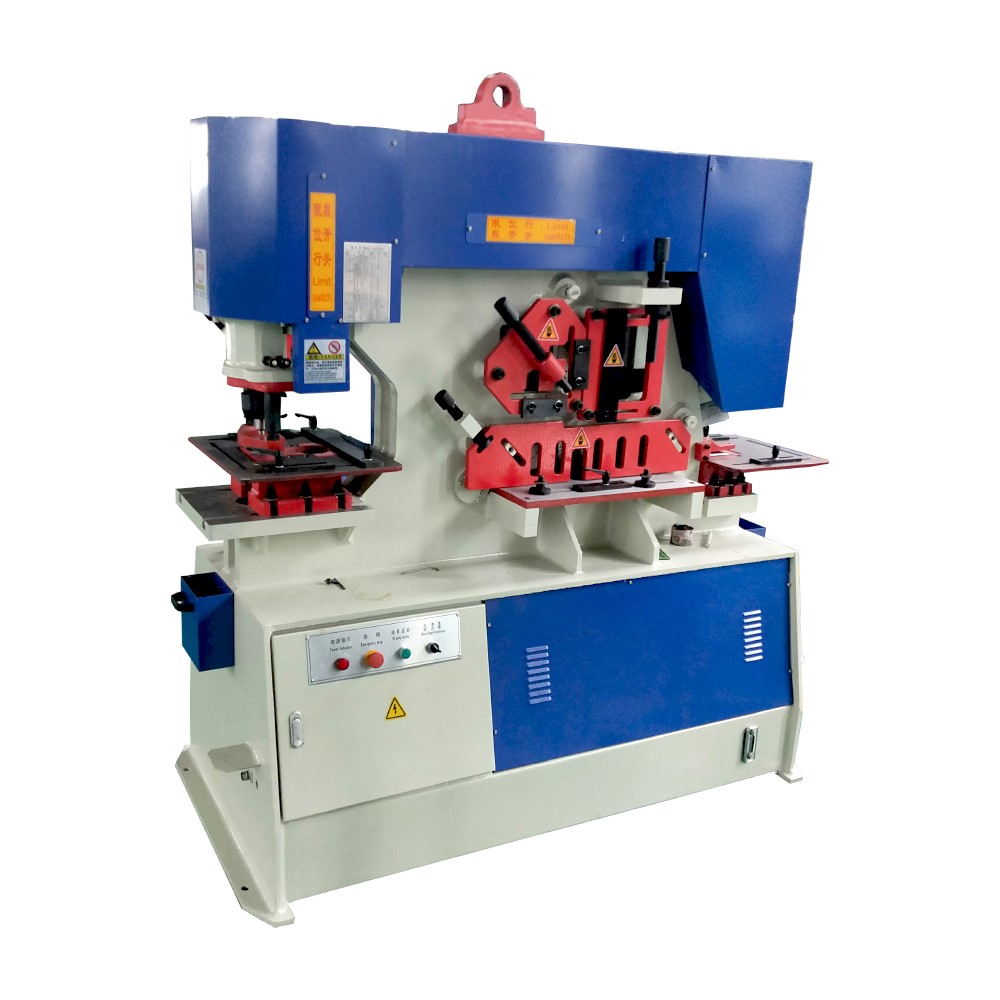Hydraulic ironworker machines represent the backbone of modern metalworking and fabrication industries. These robust and versatile machines harness the power of hydraulic systems to execute a myriad of tasks with precision and efficiency. From cutting and punching to shearing and notching, hydraulic ironworkers play a pivotal role in shaping metal materials into various forms and sizes. In this comprehensive guide, we will delve into the intricacies of hydraulic ironworker machines, uncovering the techniques and strategies to unlock their full potential and elevate your metalworking processes to new heights of productivity and effectiveness.
Table of contents
1.Understanding Hydraulic Ironworker Machines
2. Hydraulic Ironworker Machine Safety Precautions
3. Hydraulic Ironworker Machine Applications and Industries
4. Hydraulic Ironworker Machine Optimization Strategies
5.Selecting the Right Hydraulic Ironworker Machine
6. Hydraulic Ironworker Machine Maintenance and Care
7. Hydraulic Ironworker MachineTroubleshooting Common Issues
8. Hydraulic Ironworker MachineAdvanced Techniques for Productivity
9. Hydraulic Ironworker MachineFuture Trends and Developments
1.Understanding Hydraulic Ironworker Machines
Hydraulic ironworker machines stand as the epitome of versatility and functionality in the realm of metalworking. These machines are meticulously engineered to execute a diverse array of tasks, ranging from cutting and punching to shearing and notching, across a wide spectrum of metal materials. At the heart of their operation lies the fundamental principle of hydraulic power, where hydraulic pressure serves as the driving force behind their capabilities.
A hydraulic ironworker machine comprises several integral components meticulously crafted to synergize seamlessly and deliver impeccable performance. The hydraulic power unit serves as the powerhouse, generating the hydraulic pressure necessary to drive the machine's operations. Hydraulic cylinders act as the primary actuators, converting hydraulic energy into mechanical force to execute various tasks with precision. The punching station facilitates the precise punching of holes in metal sheets, while the shearing station enables the clean and efficient cutting of metal plates. Additionally, the notching station allows for the precise creation of notches in metal materials, further expanding the machine's versatility and utility.
2.Hydraulic Ironworker Machine Safety Precautions
Ensuring the safety of personnel is paramount when working with hydraulic ironworker machines. These powerful machines wield significant force and present inherent risks if not operated with caution and diligence. As such, adherence to strict safety protocols is imperative to safeguard operators and bystanders alike.
Personal Protective Equipment (PPE):
Proper attire is essential when operating hydraulic ironworker machines. Operators should wear appropriate PPE, including safety goggles, gloves, steel-toed boots, and ear protection, to shield themselves from potential hazards such as flying debris, sharp edges, and loud noises. Ensuring that all personnel are equipped with the necessary PPE is crucial to minimizing the risk of injury.
Workpiece Securing:
Adequate securing of workpieces is vital to prevent slippage or displacement during machine operation. Prior to initiating any tasks, operators should ensure that workpieces are firmly secured in place using clamps or fixtures. This not only promotes workpiece stability but also reduces the likelihood of accidents or mishaps resulting from unexpected movement.
Adherence to Manufacturer's Guidelines:
Strict adherence to manufacturer's guidelines and recommendations is essential to ensure safe and proper operation of hydraulic ironworker machines. Operators should familiarize themselves with the machine's user manual, paying close attention to safety instructions, operational limits, and maintenance requirements. Any deviations from manufacturer's guidelines should be avoided to minimize the risk of equipment malfunction or operator injury.
3.Hydraulic Ironworker Machine Applications and Industries
Hydraulic ironworker machines serve as indispensable tools across a multitude of industries, owing to their versatility and efficiency in metalworking applications. These robust machines find extensive use in diverse sectors, including:
Metal Fabrication:
Hydraulic ironworker machines are the backbone of metal fabrication shops, where they play a pivotal role in shaping metal materials into various forms and dimensions. From cutting metal plates to punching holes and notching materials, hydraulic ironworkers facilitate the fabrication of structural components, ornamental metals, and architectural elements.
Construction:
In the construction industry, hydraulic ironworker machines are employed for a myriad of tasks, ranging from cutting steel beams and channels to punching holes for fasteners and connectors. They are integral to the construction of buildings, bridges, and infrastructure projects, where precision and efficiency are paramount.
Manufacturing:
Manufacturers across diverse sectors rely on hydraulic ironworker machines for their metalworking needs. These machines enable the fabrication of components and parts for machinery, equipment, and consumer products. Whether it's cutting, punching, or shearing, hydraulic ironworkers streamline manufacturing processes and enhance productivity.
Automotive:
In the automotive industry, hydraulic ironworker machines are utilized in the fabrication of automotive components and assemblies. From cutting sheet metal for body panels to punching holes for brackets and supports, hydraulic ironworkers contribute to the production of vehicles with precision and accuracy.
Metalworking Workshops:
Metalworking workshops of all sizes benefit from the versatility and efficiency of hydraulic ironworker machines. These machines enable craftsmen and artisans to execute a wide range of metalworking tasks, from creating intricate designs to fabricating structural elements. Whether in small-scale workshops or large-scale manufacturing facilities, hydraulic ironworkers are indispensable tools for metalworking professionals.
4.Hydraulic Ironworker Machine Optimization Strategies
To fully harness the capabilities of hydraulic ironworker machines and achieve optimal performance, operators can implement a range of strategic approaches. Here are some key optimization strategies:
Proper Machine Setup and Alignment:
Ensure that the hydraulic ironworker machine is set up correctly and aligned accurately according to the manufacturer's specifications. Proper alignment of the various components, such as the punching station, shearing station, and notching station, is essential for achieving precise and accurate results in metalworking operations.
Optimizing Cutting and Punching Speeds:
Adjust the cutting and punching speeds of the machine based on the material type, thickness, and desired precision. Experiment with different speed settings to find the optimal balance between efficiency and quality. High-speed settings may be suitable for cutting thinner materials, while slower speeds may be preferable for thicker materials or intricate designs.
Utilizing Appropriate Tooling:
Choose the right tooling attachments and dies for the specific tasks at hand. Different tooling options are available for cutting, punching, shearing, and notching various types of metals, such as steel, aluminum, and stainless steel. Selecting the appropriate tooling ensures optimal performance and minimizes wear and tear on the machine.
Regular Maintenance and Lubrication:
Implement a comprehensive maintenance schedule to keep the hydraulic ironworker machine in peak condition. This includes regular inspection of hydraulic hoses, seals, and components for signs of wear or damage. Lubricate moving parts as per the manufacturer's recommendations to reduce friction and prevent premature wear. Additionally, ensure that hydraulic fluid levels are maintained within the recommended range and replace fluids as needed to keep the hydraulic system functioning smoothly.
Operator Training and Skill Development:
Provide operators with thorough training on the operation, maintenance, and safety procedures of hydraulic ironworker machines. Invest in ongoing skill development and training programs to enhance operators' proficiency and knowledge of the machine's capabilities. Well-trained operators are better equipped to troubleshoot issues, optimize settings, and maximize the machine's efficiency.
5.Selecting the Right Hydraulic Ironworker Machine
Choosing the appropriate hydraulic ironworker machine is crucial for meeting the demands of your metalworking operations effectively. Several factors should be taken into consideration during the selection process to ensure the chosen machine aligns with your specific needs and requirements. Here are key aspects to consider:
Capacity and Power:
Evaluate the machine's punching force and shearing capacity to determine if it can handle the types and thicknesses of metal materials you'll be working with. Ensure the machine's power output matches the intensity of your operations to avoid overloading or underutilizing the equipment.
Versatility and Capabilities:
Assess the machine's versatility and range of capabilities to ensure it can perform the desired tasks efficiently. Look for features such as multiple stations for punching, shearing, notching, and bending to accommodate various metalworking processes. Consider whether the machine offers customization options or additional attachments to expand its functionality as needed.
Throat Depth and Work Area:
Consider the throat depth and work area of the machine to determine its suitability for handling larger workpieces and accommodating complex projects. A deeper throat depth provides greater flexibility for positioning and maneuvering materials, while a spacious work area allows for easier handling and processing of oversized or irregularly shaped metal pieces.
Tooling Options and Compatibility:
Explore the available tooling options and compatibility with standard or custom dies, punches, and blades to ensure compatibility with your specific metalworking tasks. Verify that the machine supports a wide range of tooling sizes and types to accommodate diverse applications and materials.
Ease of Use and Maintenance:
Evaluate the machine's user-friendly interface, accessibility of controls, and ease of setup and operation to streamline workflow and minimize downtime. Look for features such as intuitive controls, ergonomic design, and quick-change tooling systems that enhance usability and efficiency. Additionally, consider maintenance requirements and accessibility for routine servicing, lubrication, and repairs to ensure hassle-free operation and longevity of the machine.
6. Hydraulic Ironworker Machine Maintenance and Care
Ensuring the ongoing performance and longevity of hydraulic ironworker machines requires diligent maintenance and care practices. Here's a comprehensive overview of maintenance tasks and care procedures to follow:
Regular Inspections:
Conduct routine inspections of the hydraulic system, including hoses, fittings, seals, and connections, to identify any signs of wear, leaks, or damage. Addressing issues promptly can prevent further damage and potential system failures.
Fluid Checks and Changes:
Monitor hydraulic fluid levels regularly and replenish or replace fluids as needed to maintain proper lubrication and hydraulic system function. Follow manufacturer recommendations for the type and viscosity of hydraulic fluid to ensure compatibility and optimal performance.
Lubrication of Moving Parts:
Apply lubricants to moving parts, such as guide rails, bearings, and cylinders, to minimize friction and wear, and ensure smooth operation. Use lubricants recommended by the manufacturer and adhere to scheduled lubrication intervals for optimal results.
Cleaning and Debris Removal:
Keep the machine and its surrounding area clean and free of debris, dust, and metal shavings to prevent contamination of hydraulic components and maintain a safe working environment. Use compressed air, brushes, or vacuum cleaners to remove accumulated debris effectively.
Alignment and Calibration:
Periodically check and adjust the alignment of machine components, such as punch and shear blades, to ensure precision and accuracy in cutting and punching operations. Calibrate the machine according to manufacturer specifications to maintain consistency and quality in output.
Safety System Checks:
Verify the functionality of safety features and emergency stop mechanisms regularly to ensure they are operational and effective in case of emergencies. Conduct test runs and drills to familiarize operators with safety procedures and response protocols.
Documentation and Record-Keeping:
Maintain detailed records of maintenance activities, including inspection dates, fluid changes, lubrication schedules, and any repairs or adjustments performed. Keep track of component replacements and service intervals to stay proactive in preventive maintenance efforts.
By implementing a systematic maintenance and care regimen for hydraulic ironworker machines, operators can minimize downtime, prolong equipment lifespan, and ensure safe and efficient operation in metalworking applications. Regular maintenance not only preserves the machine's performance but also contributes to a safer and more productive work environment for operators.
7. Hydraulic Ironworker Machine Troubleshooting Common Issues
Even with regular maintenance, hydraulic ironworker machines may experience occasional issues that require troubleshooting. Here are some common problems operators may encounter and steps to address them:
Hydraulic Leaks:
If hydraulic fluid leaks are detected, immediately shut down the machine and identify the source of the leak. Inspect hydraulic hoses, fittings, seals, and connections for damage or wear. Replace damaged components and tighten loose fittings as needed. Refill hydraulic fluid to the appropriate level after resolving the leak.
Tool Misalignment:
Misalignment of cutting or punching tools can result in inaccurate or uneven cuts and punches. Check the alignment of punch and shear blades, ensuring they are properly seated and aligned according to manufacturer specifications. Adjust the tooling as necessary to achieve proper alignment and uniformity in operations.
Mechanical Failures:
Mechanical failures, such as jammed or stuck components, may occur due to excessive force or material buildup. Shut off the machine power and manually clear any obstructions or debris from the affected areas. Inspect moving parts for signs of damage or wear and replace worn-out components promptly to prevent further issues.
Electrical Malfunctions:
Electrical issues, such as power fluctuations or control panel failures, can disrupt machine operation. Check electrical connections, fuses, and circuit breakers for loose connections or damage. Test electrical components and wiring using a multimeter to identify and resolve any issues with power supply or control circuits.
Hydraulic System Malfunctions:
Problems with the hydraulic system, such as low pressure or slow operation, may indicate issues with hydraulic fluid levels, pump performance, or valve functionality. Check hydraulic fluid levels and replenish or replace fluid as needed. Inspect hydraulic pumps, valves, and cylinders for signs of wear or malfunction and address any issues promptly.
Noise or Vibration:
Unusual noises or vibrations during machine operation may indicate mechanical problems or component failure. Conduct a visual and auditory inspection of the machine while in operation to identify the source of the noise or vibration. Tighten loose bolts or fasteners, lubricate moving parts, and replace worn-out bearings or bushings to reduce noise and vibration levels.
Error Codes or Alarms:
Modern hydraulic ironworker machines may be equipped with diagnostic systems that display error codes or alarms to indicate specific issues. Refer to the machine's manual or documentation to interpret error codes and troubleshoot the underlying problems accordingly. Follow recommended procedures to reset alarms or address error conditions to resume normal operation.
By familiarizing themselves with these common troubleshooting techniques, operators can quickly identify and resolve issues with hydraulic ironworker machines, minimizing downtime and ensuring continued productivity in metalworking operations. Regular inspections, proactive maintenance, and operator training are essential for preventing issues and maintaining optimal machine performance over time.
8. Hydraulic Ironworker Machine Advanced Techniques for Productivity
To maximize the productivity of hydraulic ironworker machines, operators can implement advanced techniques and strategies tailored to their specific workflow requirements. Here are some advanced techniques to consider:
Batch Processing:
Instead of processing individual workpieces sequentially, batch processing involves grouping similar tasks together and performing them simultaneously. This approach minimizes setup time and maximizes machine utilization, resulting in higher throughput and productivity. Operators can organize workpieces based on size, material type, or processing requirements to optimize batch processing.
Tool Optimization:
Utilizing the right tooling is critical for achieving optimal results with hydraulic ironworker machines. Operators should explore the full range of available tooling options, including punches, dies, and blades, to match the requirements of different applications. Investing in high-quality tooling with advanced features such as quick-change capabilities, variable angles, and extended tool life can improve efficiency and reduce downtime.
Material Handling Automation:
Automation technologies such as robotic loaders, conveyor systems, and material handling robots can streamline material handling processes and improve overall workflow efficiency. Integrating automated material handling solutions with hydraulic ironworker machines allows for seamless loading, unloading, and sorting of workpieces, reducing manual labor and increasing throughput.
Programmable Controls and Software Integration:
Many modern hydraulic ironworker machines are equipped with programmable controls and software interfaces that enable customization and automation of machine operations. Operators can program specific cutting, punching, and shearing sequences, optimize tool paths, and store custom job setups for quick recall. Integration with CAD/CAM software and production management systems facilitates seamless data transfer and workflow synchronization, further enhancing productivity.
Continuous Improvement and Training:
Continuous improvement initiatives, such as Lean manufacturing practices and Six Sigma methodologies, can help identify areas for optimization and efficiency gains in metalworking operations. Regular training and skills development programs ensure that operators are proficient in operating and maintaining hydraulic ironworker machines, maximizing their productivity potential.
By leveraging these advanced techniques and embracing continuous improvement principles, operators can unlock the full productivity potential of hydraulic ironworker machines, driving efficiency, competitiveness, and profitability in metalworking businesses. Experimenting with different strategies and technologies allows operators to tailor their workflows to meet evolving production demands and achieve sustainable growth.
9.Hydraulic Ironworker Machine Future Trends and Developments
The future of hydraulic ironworker machines is shaped by ongoing advancements in technology and automation. Manufacturers are constantly innovating to enhance machine capabilities, improve performance, and meet the evolving needs of metalworking industries. Here are some key trends and developments to watch for in the future:
IoT Integration:
The integration of Internet of Things (IoT) technology into hydraulic ironworker machines enables real-time monitoring and data collection. IoT-enabled machines can communicate performance metrics, operational status, and maintenance requirements to a central control system or cloud platform. This data-driven approach allows for proactive maintenance scheduling, predictive analytics, and optimized machine utilization.
Predictive Maintenance:
Predictive maintenance algorithms leverage machine data and analytics to predict equipment failures before they occur. By analyzing trends and patterns in machine performance, predictive maintenance systems can identify potential issues early and schedule maintenance tasks accordingly. This proactive approach minimizes unplanned downtime, reduces repair costs, and extends the lifespan of hydraulic ironworker machines.
Remote Monitoring and Control:
Remote monitoring and control capabilities enable operators to monitor machine operations and make adjustments from anywhere with an internet connection. This remote accessibility enhances flexibility, facilitates troubleshooting, and enables real-time decision-making. Operators can remotely monitor production progress, receive alerts for potential issues, and adjust machine settings as needed, improving overall efficiency and responsiveness.
Advanced Automation:
Advances in automation technology are driving increased levels of automation in hydraulic ironworker machines. Integrated robotic systems, automated tool changers, and robotic material handling solutions are becoming increasingly prevalent, automating repetitive tasks and streamlining production workflows. Advanced automation capabilities improve productivity, reduce labor costs, and enhance overall process efficiency.
Enhanced Precision and Accuracy:
Manufacturers are continually refining machine designs and incorporating advanced control systems to enhance precision and accuracy in hydraulic ironworker machines. Features such as servo-driven controls, laser positioning systems, and automatic material feeders contribute to tighter tolerances, improved part quality, and reduced scrap rates. Enhanced precision enables operators to tackle complex cutting, punching, and shearing tasks with confidence, opening up new possibilities for intricate designs and applications.
As these trends continue to evolve, hydraulic ironworker machines will play a pivotal role in driving innovation and efficiency in metalworking industries. By embracing emerging technologies and staying abreast of industry developments, manufacturers and operators can position themselves for success in an increasingly competitive marketplace.
10. Conclusion
In summary, hydraulic ironmaking machines are important assets for the metal processing and manufacturing industry, providing versatility, efficiency and reliability in a variety of applications. By fully understanding their operating principles, adhering to strict safety protocols and implementing effective optimization strategies, the full potential of these machines can be unleashed to streamline production processes and achieve superior results.
Additionally, regular maintenance and proactive care are essential to ensure the longevity and optimal performance of your hydraulic ironing machine. By conducting routine inspections, making necessary repairs, and adhering to manufacturer recommendations, operators can reduce the risk of unplanned downtime and maintain peak operational efficiency.
As technology continues to advance and industry needs evolve, hydraulic ironmaking machines will continue to drive productivity improvements in metalworking operations.
This guide provides a basic understanding of Hydraulic ironworker machines. To learn more about metalworking machines, visit our tutorials, or visit the KRRASS supplier discovery platform to find potential sources or view details for a specific product.





